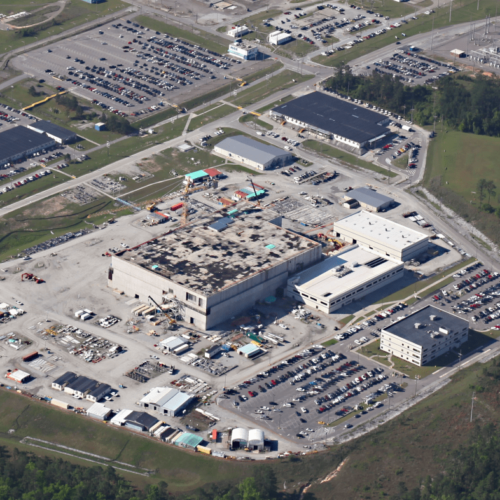Introduction
A U.S. effort to dispose of 34 tons of surplus plutonium from scrapped nuclear weapons has been long been stymied by cost overruns and technical problems. But now it seems the challenges to proceeding are even steeper than anticipated, with a new Energy Department study saying that a startling, year old cost estimate may still be billions of dollars short.
The older study led by John MacWilliams, an advisor to Energy Secretary Ernest Moniz, estimated the lifetime cost of the so-called Mixed Oxide (MOX) plutonium elimination project in South Carolina at over $25.1 billion.
But the new study, conducted by a U.S. Air Force-funded research and development center known as the Aerospace Corporation, says the effort could cost at least $30.7 billion to complete, according to a summary that was presented to lawmakers on Capitol Hill.
After the summary was obtained by the Union of Concerned Scientists, a nuclear safety advocacy group, Energy Department officials confirmed that the study concluded this cost might even balloon to $47.5 billion.
The higher pricetag would ensue if, as MacWilliams’ study assumed last year, annual spending on the program is capped at $500 million annually, which would drag out its completion. If spending were limited to $375 million a year — an amount close to what Congress has recently appropriated — the cost of the overall project could eventually reach $110.4 billion, the summary stated.
None of these figures include the sums spent so far to build a plant at the Savannah River Site in South Carolina to mix the plutonium with uranium and produce fuel for U.S. commercial reactors. The plant is about 65 percent complete and $4.1 billion has already been spent, according to the Energy Department.
An alternative plan to turn the plutonium into reactor fuel: simply diluting the plutonium by mixing it with a classified material and burying it, could cost up to $17.2 billion, the document states.
Derrick Robinson, a spokesman for the National Nuclear Security Administration, confirmed in an email that the fuel option could cost $47.5 billion while the burial option could $17.2 billion, as outlined in the summary. He said both figures were calculated to include anticipated inflation, which was “consistent with the best practices and industry standards for cost estimating.”
Robinson said the full report was released to Congress April 22, but was considered “for Official Use Only” and would not be publicly available. “Aerospace is working on a version of the report that has no distribution restriction,” he said, adding that the process could take a few months.
Edwin Lyman, senior scientist with the group’s Global Security Program, said that the summary was consistent with a slide presentation outlining the full report’s conclusions, which was presented April 21 on Capitol Hill. “These eye-popping numbers just underscore how completely unsustainable the MOX program is,” Lyman said. “We have to stop wasting more money on a white elephant.”
Bryan Wilkes, a spokesman for the contractor building the fuel plant at Savannah River, CB&I Project Services Group, said in an email that “we vigorously disagree with this report.” He called the Aerospace “cost figures … inaccurate and unsubstantiated,” citing the MacWilliams study and other earlier government reports.
Jessica Brown, a spokeswoman for the Aerospace Corporation, said that no one was immediately available to speak about the report.
The plutonium disposal effort grew out of a post-Cold War U.S. agreement with Russia to each get rid of 34 tons of their surplus weapons plutonium, partly to discourage another arms race and partly to keep the material from being stolen for sale on the black market. The combined total of 64 tons slated for disposal could be used to make 17,000 bombs.
Under the deal, signed in 2000, the United States pledged to turn some of the weapons fuel into a mixed-plutonium and uranium oxide fuel, called MOX, for use in commercial reactors.
The DOE planned to bury the rest encased in large canisters filled with glass that contained highly-radioactive materials. But the Bush administration abandoned this option in 2002. Russia always planned to burn the plutonium as reactor fuel.
Construction of the U.S. MOX plant began in 2007. While the shell is largely complete, the structure must still be equipped with the piping and specialized machinery needed for turning the mixed plutonium and uranium into fuel pellets.
The escalating cost of the MOX project led the White House in 2014 to try to put construction of the South Carolina plant on cold standby, essentially shutting it down. But that plan was thwarted by South Carolina’s congressional delegation, including its Republican senior senator, Lindsay Graham.
A November 2014 report to Secretary of Energy Ernest Moniz by the Contract and Project Management Working Group, which included senior managers from seven DOE offices, concluded that the department had underestimated the costs of the MOX project from the start.
The Working Group’s report said that the DOE’s cost calculations were flawed because they were not subjected to peer review and because the department had not analyzed the construction or operating costs of the French MOX plant that served as a model for the Savannah River facility. The report also found that the DOE had not conducted a “rigorous” risk analysis or review of the technology.
Read more in National Security
Nuclear Waste
Obama steps back from sweeping nuclear security goal
The administration looks for incremental gains in locking up nuclear explosives, rejecting demands by outsiders for a major new international agreement to prevent nuclear terrorism
National Security
Former Energy Department official wins huge pay raise after moving to firm with deep ties to DOE
His new employer is seeking a $2 billion loan guarantee from his former employer, and he’s already chatting about the company with officials at a DOE lab


Join the conversation
Show Comments